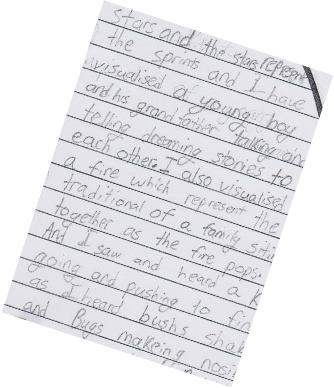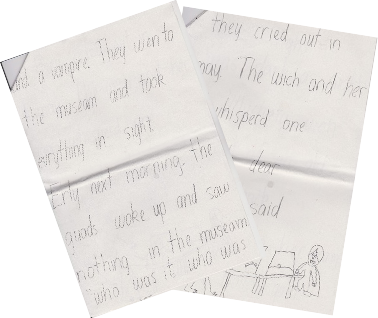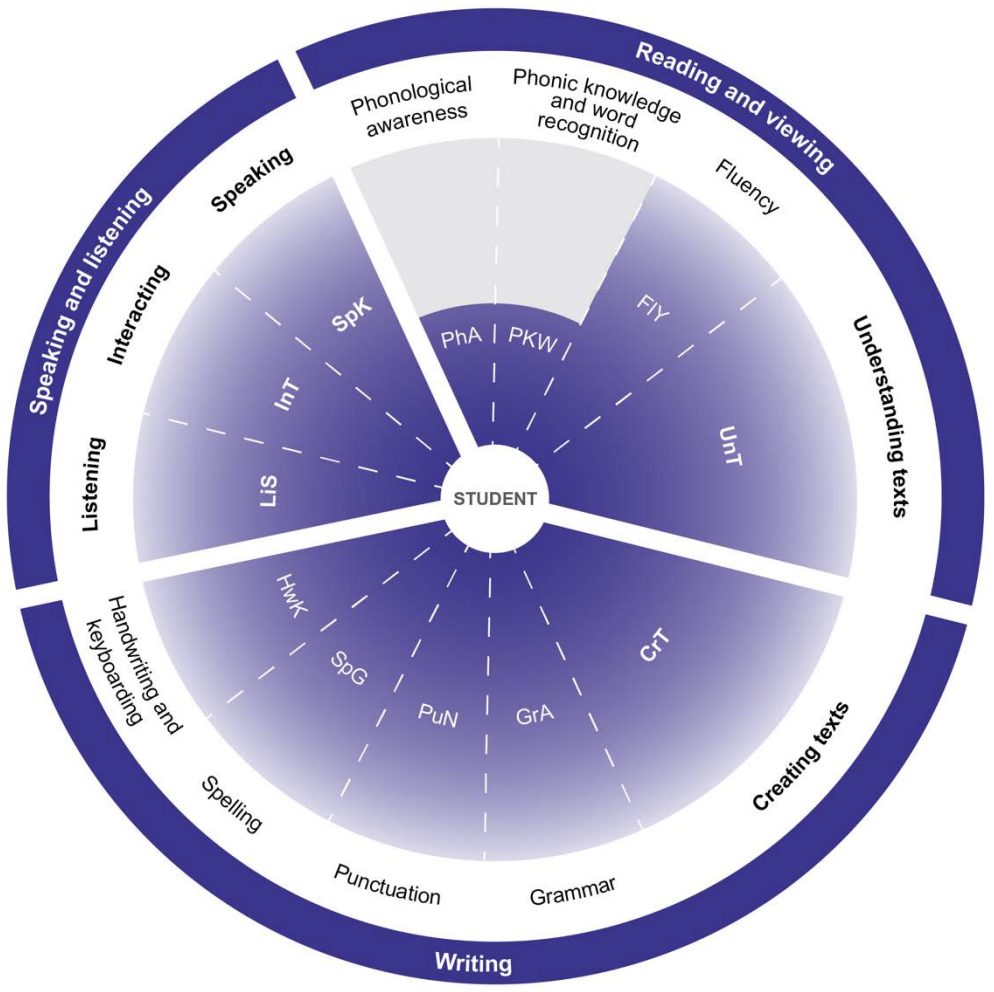I have had a query from a concerned teacher, a member of the school’s Literacy Committee, about ways to ‘effectively boost spelling outcomes across the school’.
Start with mandatory documents
- The Australian Curriculum has spelling as a sub-strand of English in the sequence of content and in Word Knowledge, in the learning continuum.
- In NSW, the NESA English K-6 English Syllabus includes spelling in Outcome 5A, ‘Students learn to communicate through speaking, listening, reading, writing, viewing and representing*’. Some detail is provided in the outcomes from Early Stage 1 (the first year of school) through to Stage 2 (the end of Year 4).
Support documents
- The Australian Curriculum provides support for the teaching of spelling through the National Literacy Progression, which describes some of the observable behaviours of students. Spelling sits in Creating Texts, and is linked to phonic knowledge and word recognition.
- NSW Department of Education curriculum resources can be found here.
- In Victoria, comprehensive background and support is provided at Education & Training Victoria
- Queensland has a very detailed and comprehensive draft resource titled Scope and Sequence: Spelling
There’s a lot of overview, but not a lot of content, for a teacher asking about effectively teaching spelling.
Whole school decision
A whole-school approach is an effective way to ensure consistency in approach from the first to the last years of primary school. Making a decision about the spelling resources and programs you are going to use in your school takes a bit of work.
At Stage or whole school level you want to be clear about the following:
- What do you already know and understand about spelling?
- What do you want to achieve, for your students and for your school?
- What skills are your students demonstrating?
- What understandings do your students have about spelling?
- What understandings do your students’ parents have about spelling?
If you are undertaking this as a group, you will need a couple of meetings at least. For a whole school decision, the P&C and wider parent body can be involved to help support long-term commitment.
Such an approach can involve consideration of the purchase of commercial products. This can be expensive, both financially and in long-term commitment. It is difficult to discontinue the use of such a resource when it does not meet the needs of teachers or students.
Everything you learn from the following will inform your teaching.
What do you already know and understand about spelling?
Spelling is a system for making meaning of written text, for both writers and readers, within a particular language community.
Definition: the forming of words from letters according to accepted usage: ORTHOGRAPHY
Meriam-Webster
The term Orthography is now widely used in education, as it refers to the writing or printing of words. Spelling isn’t required for meaning-making in spoken language.
We understand that there are different forms of spelling knowledge, and that each can be addressed in all Stages:
- phonological knowledge – knowledge of the sound structure of language
- orthographical knowledge – knowledge of the system of written symbols used to represent spoken language
- morphemic knowledge – knowledge of the smallest parts of words that carry meaning
- etymological knowledge – knowledge of the origins of words (Oakley & Fellowes, 2016, p.6)
We know we don’t wait until Year 4 before teaching how to turn ‘run’ into ‘running’, or that ‘trans’ comes from the Latin and means across, over or beyond, if students need that information to assist with their spelling.
Use this reference to help extend your own comprehensive knowledge of English spelling.
Importantly, correct spelling gives writing credibility and authority, and, significantly, helps writers to communicate across the boundaries of dialect and pronunciation (NSW DET 1999 p.8).

What do you want to achieve, for your students and for your school?
The Australian Curriculum gives us the overview of what our teaching P-6 can help our students achieve. It requires that students learn to use spelling, as they develop their knowledge about:
- sounds and letters
- letter clusters
- regular and irregular letter patterns;
to develop their understandings about:
- meanings and relationships between words using word ‘families’ and how to form these
- word origins
- base words
- prefixes and suffixes
and to be able to draw on these when spelling unfamiliar words.
ref: General capabilities – Literacy – learning continuum p.6
We can link each of these to the different forms of spelling knowledge.
The goals you want to achieve for your school would be to have every student skilled and confident in their spelling of both familiar and unfamiliar words in their writing.
What skills are your students demonstrating? What understandings do your students have about spelling?
Spelling capability is demonstrated in its application in student writing – it’s the using and applying of knowledge and understanding that is the measure.
Spelling is one of the elements of literacy that is given prominence in the annual national testing program for Years 3, 5, 7 and 9. Spelling usually comprises more than 50% of questions in the Language Conventions section of the test in all grades, using random sentences with words which have particular application of spelling conventions.
The results give limited indication of the types of spelling knowledge our students can apply. The analysis of the Writing component of the test can provide some information.
The weekly spelling test doesn’t provide the richness that student writing does. Commercial word lists are ‘graded’, predictable and often irrelevant to the needs of the students. They are standardised, based on erroneous hierarchical attitudes towards the acquisition of spelling understandings, and have little to do with students’ demonstrated need, their knowledge and understandings, their interests or class topics.
It is the writing that students do every day as they make notes, draft texts, edit and revise their writing, and construct shared pieces of work, which is the demonstration of spelling knowledge, and which gives us our most valuable information.
As Adoniou states:
For those interested in a meaning-based repertoire approach to teaching spelling, there are no commercial spelling programs. There are many spelling programs that focus primarily on the development of phonological and orthographical spelling knowledge …
Adoniou 2016 p.74

We want to go deeper than that if our students are to get to being able to draw on knowledge and understandings when spelling the unfamiliar words they will come across and want to use in rich, authentic texts and contexts.
What understandings do your students’ parents have about spelling?

Many parents have little knowledge of the history of English spelling, the various sources of spelling knowledge, or the most effective ways to teach spelling. They tend to be fastidious in their awareness of spelling errors in their children’s writing, and expect that every one of these should be corrected. How this assists children to learn to spell is unclear. It is as much to do with showing that you, as a teacher, are an expert speller, and are scrupulous in the identification and correcting of ‘mistakes’.
We have to show parents that our knowledge of learning about spelling has expanded since they were at school, doing the weekly spelling test.
We can keep them informed about the different forms of spelling knowledge and how these are being developed in student writing.
Have a close look at what you are doing now
- What is the context for teaching and learning about spelling in the classroom?
- What is the purpose for teaching spelling? Do you and the students ‘do’ spelling, or is your focus the way that words in English are developed and constructed?
- Are your students transferring what they learn in spelling lessons to their writing and to their editing of written work? This is the best indicator of how well understandings are being applied.
- Who is the audience for correct spelling for your students? Do students take any notice if you mark errors? Or is it for parents? You actually don’t need the practice, as you already know how to spell most words your students are learning. If you don’t, then extend your knowledge and understanding immediately – we expect our students to learn to spell, we can too.
- Are you using a ‘one size fits all’ program that does not allow for the individual needs of students?
- Is you program centred on the phonological knowledge about spelling? There are 26 letters which are used to represent the 44 sounds in English, and these can be spelt using more than 1200 letter combinations; we simply cannot remember these just as ‘strings of letters’ (Adoniou 2016 p.5-6).
- Do you know what works for your students? Do you talk about how they apply their knowledge? Are they partners in this learning?
- Are you and your students excited by spelling?
The reason our words are spelled the way they are … [has] everything to do with history and society. Every word in English represents a story – a mini-lesson in history, geography, linguistics, sociology and politics.
Adoniou 2016 p.5
There is no one method or strategy to ensure a person learns to spell. Students don’t learn to spell from the same kind of teaching. Students need a repertoire of strategies and understandings about our language.
Effective instruction in spelling involves students in the study of words from a phonological, orthographic and morphological perspective. Such study of words should occur regularly, and it can be embedded across all subject areas.
Daffern 2020 p.181
Strong knowledge and commitment to these understandings are sure to ‘effectively boost spelling outcomes across the school’.
Resources
Dr Tessa Daffern: You can access her website, You Tube videos, and can purchase publications.
Dr Noella Mackenzie: her website includes links to her blogs (most recently about reading), resources and publications.
NSW Department of Education: In conversation with Dr Tessa Daffern: Teaching Spelling, Podcast, at https://soundcloud.com/user-770146497/dr-tessa-daffern-teaching-spelling
NZ http://arb.nzcer.org.nz/supportmaterials/english/thinking-about-how-language-works.php#s3
Primary Learning blog (2018) Thinking about Context Part 1: Writing the Future – PETAA Professional Learning Intensive 2018
References
ACARA (2012) https://australiancurriculum.edu.au/f-10-curriculum/general-capabilities/literacy/ in PDF documents
Adoniou, M. (2016) Spelling it Out: How words work and how to teach them Sydney: Cambridge Press
Daffern, T. & Mackenzie, N. (Eds) (2020) Teaching Writing: Effective approaches for the middle years Sydney: Allen and Unwin
Education & Training Victoria https://www.education.vic.gov.au/school/teachers/teachingresources/discipline/english/literacy/writing/Pages/litfocusspelling.aspx accessed 08/06/2020
Meriam-Webster online dictionary at https://www.merriam-webster.com/dictionary/spelling accessed 08/06/2020
NSW Department of Education and Training (1999) Focus on Literacy: Spelling Sydney: NSW DET







